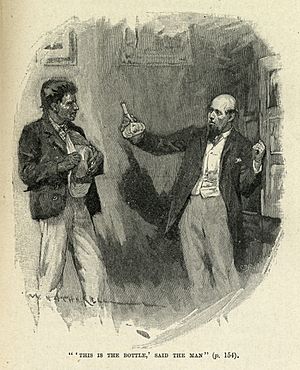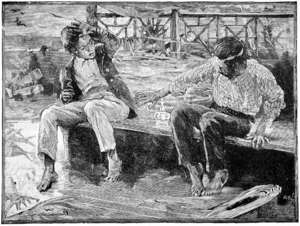The Bottle Imp facts for kids
"The Bottle Imp" is a short story written by the Scottish author Robert Louis Stevenson in 1891. It is often found in his book Island Nights' Entertainments. The story was first printed in newspapers and magazines like the New York Herald and Black and White. In the story, a man buys a special bottle that has a magical imp inside. This imp can grant wishes. However, there's a big problem: if the person who owns the bottle dies while still having it, their spirit will be lost forever.
Contents
Story of the Bottle Imp
Keawe, a poor man from Hawaii, buys a strange bottle that cannot be broken. He buys it from an old, sad man who says the bottle made him rich. The old man promises that a magical imp living inside the bottle will grant Keawe anything he wishes for.
The Bottle's Rules
There is a very important rule for the bottle. It must always be sold for money, and for less than the owner paid for it. You cannot throw it away or give it to someone for free, or it will magically come back to you. Every seller must clearly explain all these rules to the new buyer. If someone dies while owning the bottle without selling it the right way, their spirit will be lost forever.
The story says the bottle was brought to Earth by the Devil. Famous people like Prester John, Napoleon, and Captain James Cook once owned it. Their great successes were said to be because of the bottle. By the time Keawe buys it, its price has dropped to fifty dollars.
Keawe's Wishes
Keawe buys the bottle and quickly tests it. He wishes for his money back, tries to sell it for more than he paid, and tries to leave it behind. When everything happens just as the old man described, Keawe realizes the bottle truly has a strange power. He then wishes for his biggest dream: a large, beautiful house with land. His wish comes true, but there is a sad cost. His uncle and cousins die in a boating accident, making Keawe the only person to inherit his uncle's money. Keawe is very upset, but he uses the money to build his house. Once he has everything he wants and is happy, he explains the bottle's dangers to a friend, who then buys it from him.
A New Problem
Keawe lives a happy life, but he feels something is missing. One night, while walking on the beach, he meets a beautiful woman named Kokua. They quickly fall in love and decide to get married. However, Keawe's happiness is ruined on the night they get engaged. He finds out he has a serious illness called leprosy, which was very hard to cure back then. He knows he must leave his house and his wife and live in Kalaupapa, a special community for people with leprosy. His only hope is to get the bottle back and use it to cure himself.
Finding the Bottle Again
Keawe starts looking for the bottle. He tries to find the friend he sold it to, but his friend has become rich and left Hawaii. Keawe follows the bottle's path through many different owners. Finally, he finds a Haole (a person of European background) in Honolulu. This man has both good and bad news for Keawe. The good news is he owns the bottle and is happy to sell it. The bad news is he only paid two cents for it. This means if Keawe buys it, he will not be able to sell it for less than one cent, which would be impossible.
Keawe decides to buy the bottle anyway for one cent and uses it to cure himself. But now, he is very sad. How can he enjoy life knowing his spirit will be lost forever? His wife thinks he is sad about their marriage and asks for a divorce. Keawe then tells her his secret about the bottle.
Kokua's Sacrifice
His wife, Kokua, suggests they sail to Tahiti. In Tahiti, people use centimes, which are coins worth less than an American cent. This gives Keawe a small hope.
However, when they arrive, the local people are suspicious and do not want to touch the cursed bottle. Kokua decides to make a huge sacrifice to save her husband. She knows Keawe would never knowingly sell the bottle to her. So, Kokua secretly pays an old sailor to buy the bottle for four centimes. The sailor agrees, understanding that Kokua will secretly buy it back from him for three centimes. Now Keawe is happy, but Kokua carries the curse.
Freedom from the Curse
Keawe soon finds out what his wife has done. He decides to sacrifice himself for her in the same way. He arranges for a rough boatswain (a sailor) to buy the bottle for two centimes, promising to buy it back for one centime. This would seal Keawe's doom. However, the drunken sailor refuses to sell it back. He is not afraid of his spirit being lost. "I reckon I'm going anyway," he says.
Keawe returns to his wife. Both of them are now free from the bottle's curse. The story suggests they live happily ever after.
Story Background
The idea of a magical bottle with an imp inside can also be found in an old German legend called Spiritus familiaris by the Brothers Grimm. When Stevenson's story was published in 1891, the Kingdom of Hawaii used its own cent coins, which were worth the same as a U.S. penny.
The story shows what Stevenson learned during his five-month visit to Hawaii in 1889. Part of the story happens in the small town of Hoʻokena on the Kona coast of the island of Hawaii, which Stevenson visited. In a scene that takes place in Honolulu, Stevenson mentions Heinrich Berger, the leader of the Royal Hawaiian Band. The name of Keawe's wife, Kokua, comes from the Hawaiian word kōkua, which means help. In 1889, Stevenson also visited the leper colony on the island of Molokaʻi and met Father Damien there. This gave him a real understanding of what people with leprosy faced. Stevenson often uses the Hawaiian word Haole for people of European background, for example, when describing the last owner of the bottle.
The story can be seen as a different take on the idea of selling one's spirit to the Devil. This theme is found in many other stories, like those about Doctor Faust, and "The Devil and Tom Walker" by Washington Irving.
Other Versions of the Story
Many different versions of "The Bottle Imp" have been made:
- A silent film based on Stevenson's story came out in 1917. It starred Sessue Hayakawa.
- A horror radio show called The Witch's Tale adapted the story as "The Wonderful Bottle" in 1934.
- Two European films were made in the 1930s: the German film Love, Death and the Devil (1934) and the French film The Devil in the Bottle (1935).
- A West German stop motion animated movie called Der Flaschenteufel was released in 1952.
- An Italian TV show called "Il diavolo nella bottiglia" aired in 1981.
- The Imp In The Bottle was an episode of the CBS Radio Mystery Theater in 1974.
- An opera called The Devil Inside, based on the story, premiered in 2016. It was written by Louise Welsh and Stuart MacRae.
- The story also inspired a card game called Bottle Imp, first published in 1995.
fr:Veillées des Îles#La Bouteille endiablée
|
See also
 In Spanish: El diablo de la botella para niños
In Spanish: El diablo de la botella para niños




